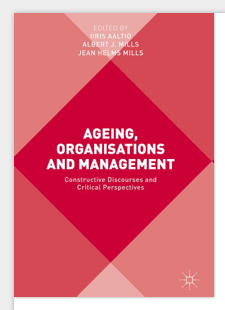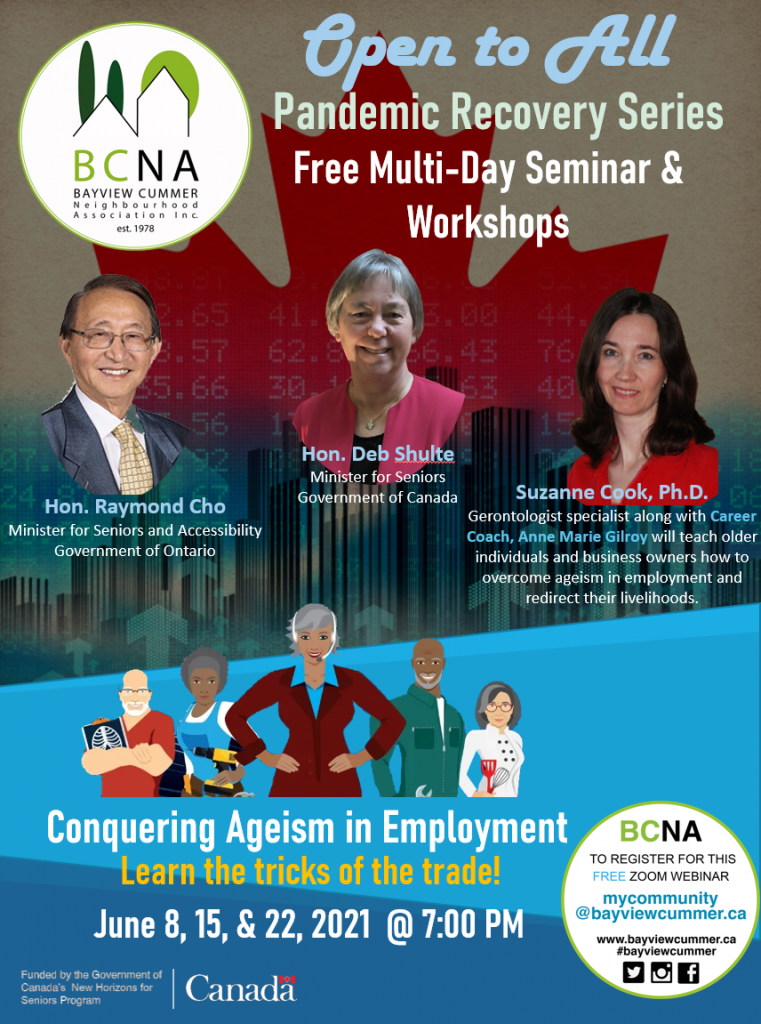Workshop Series
Posted by suzanne on Jun 7, 2021
It is exciting to share that a new workshop series is beginning June 8th, 2021. The series is entitled Pandemic Recovery Series Conquering Ageism in Employment and is hosted by the Bayview Cummer Neighbourhood Association (BCNA). It will assist mature workers who are looking for work and seeking a meaningful challenge.
Career Coach Ann Marie Gilroy and I are co-leading the series. It runs June 8th, 15th, and 22nd. It is free to attend.
Pre-register through this link: https://us02web.zoom.us/meeting/register/tZAsdemsrD8oHNfyC0GO44V5lklKB7mrRZTB
For more information visit: http://www.suzannecook.ca/workshops/

Category: Active Engagement, Aging, Aging Population, Aging Workforce, Business, Career, Economic Issues, Health and Wellness, Intergenerational, Lifelong Learning, Longevity, New Retirement, Redirection, Relationships, Social Participation, Social Policy, The Redirection Project, Vital Engagement, Work
 Post Tagged with Ageism, Aging Labour Force, Aging Population, Community, Documentary Film, Elderhood, Employment, Engagement, Experienced Workers, Finance and Economics, Income and Lifestyle, Intergenerational, Later Life Work, Mature Workforce, Meaningful-Later-Life-Work, Narrative, New Retirement, Older Workers, Redirection, Redirection Project, Skills, Storytelling, Well-being
Post Tagged with Ageism, Aging Labour Force, Aging Population, Community, Documentary Film, Elderhood, Employment, Engagement, Experienced Workers, Finance and Economics, Income and Lifestyle, Intergenerational, Later Life Work, Mature Workforce, Meaningful-Later-Life-Work, Narrative, New Retirement, Older Workers, Redirection, Redirection Project, Skills, Storytelling, Well-being Aging Workforce and Policy
Posted by suzanne on Nov 28, 2020
I think it is timely to repost this blog from a few years ago. These key issues remain.
The population is aging in Canada as the baby boomer generation approaches and enters their later years. In a similar vein, the Canadian labour force is aging.
The aging population and labour force affect the Canadian economy. Policy makers, economists and government are concerned about how this will impact the economy.
Canada’s population growth is dependent upon the fertility rate, death rate and rate of immigration. Fertility rates have decreased over the decades as women have fewer children. Canadians are living longer. Immigration policy in Canada aims to bring more people into the country who can contribute to productivity and growth and compensation for the low fertility rate to keep the economy strong.
However, government, policy makers and economists do not fully recognize that older workers are eager to work and continue to work, in order to contribute to their communities. Older workers are skilled and experienced workers. They have communication, interpersonal and problem solving skills and have developed their ability to work with others. All of these skills are essential in the workplace today.
Organizational Level
As the populations ages and the workforce becomes older, all levels of society are impacted by demographic change. Importantly, this impacts organizations who are worried about a chronic labour shortage resulting from a rapidly aging population. Organizations have identified skill shortages in different roles across various industries. This is a top priority for business leaders.
Around the globe, other countries are innovating to address these concerns. These countries believe that the best way to adopt a successful aging strategy is to realize that aging is an opportunity.
One example is Japan, where policy makers have been steering the growing number of healthy 60- and 70 year olds away from retirement into work. These mature workers are taking on work roles and this makes them productive members of society. They hold jobs ”that otherwise would be impossible to fill as the population shrinks.”1
Furthermore, an entrepreneurial focus on the aging demographic, with products and services to support aging, ensures that aging is a benefit that broader society can reap.
Although consumer spending growth overall is weak in Japan, economists at UBS Securities there say they believe the expansion of the senior market could more than offset any declines that come from a shrinking population, at least for a time.2
For Japan, the way forward is clear. For more, visit Aging Gracefully in the Wall Street Journal.
Footnotes:
1 Schlesinger, J. M. & Martin, A. (2015). Entrepreneurs are exploring robotics and other innovations to unleash the potential of the elderly. Aging Gracefully: Graying Japan Tries To Embrace the Golden Years.
2 Ibid.
6 Tips for Enhancing Motivation
Posted by suzanne on Nov 5, 2017
People sometimes ask me, “Are there ways to enhance motivation?” It can be difficult to keep trying to find new work opportunities or your ‘redirection’ when there are significant barriers and obstacles in the way.
It is important to find ways to motivate yourself to reach toward your goals and objectives. What are the best ways to enhance motivation?
Here are six tips:
- Set your Ikigai. Ikigai is pronounced ‘ee-kee-guy’ and is your reason for being, or your reason to get up in the morning. This is a Japanese term that I learned after reading Neil Pasricha’s book The Happiness Equation. An Ikigai is like the ‘la raison d’être’ in French. Write out your Ikigai. Put it where you can see it first thing every morning.
- Set small, measurable goals or objectives. Write them down. Then, track your progress on a weekly basis.
- Choose a mantra. Use a mantra, motto or quote that connects to your goals and speaks to you. The mantra can motivate and help spur change. It points to where you are going. Pick a mantra that makes you want to reach your goals and keep moving forward.
- Select a touchstone, an image to ground and inspire you. Choose a visual image or object that makes you want to keep striving towards your goals.
- A social network can be a good source of support and encouragement. Share your goals with your family and closest friends, or more publicly with colleagues, friends, neighbours and your broader social circle or network.
- Get out and spend time everyday with nature. This regularly creates reflective time in your life to help you design, review and evaluate goals and to think about your objectives.
Good luck!

Category: Aging, Career, Economic Issues, New Retirement, Redirection, Work
Talent Management and Later Life Career
Posted by suzanne on Sep 30, 2017

Talent Management and Career Development of Older Workers: I discuss this in Chapter 6 of this new book.
The workforce is aging. This is a critical business issue and organizations are paying closer attention.
With this new demographic shift in the workplace, the talent management and career development of mature workers must be redesigned. These are two new emerging and interconnected issues that are discussed in my latest book chapter.
I co-authored Talent Management and Older Workers: Later Life Career Development, Chapter 6 of Ageing, Organisations and Management, with Victoria Rougette (see pages 113 – 140). Here is a short description of the chapter:
“The Canadian workforce is ageing and there is greater labor force participation among older adults. These unprecedented shifts require business and industry to examine the talent management of older workers while considering their career development. In fact, a top strategic issue facing organisations is the talent management of the ageing workforce such as the recruitment, retention, training and development, and career progression of older workers. This chapter examines the career development of older workers and talent management policy in organisations through a critical lens in order to shift the discourse surrounding work and ageing. This approach can support the labor force participation of older workers and their career development needs while also strengthening talent management within organisations.”
The new book, Ageing, Organisations and Management, edited by I. Aaltio, J. Helm Mills and A. Mills and published by Palgrave Macmillan, is now available.
This edited book examines business, organizations and work with a focus on aging. The chapters are written by scholars from Europe, North America and Australia. Other chapters are entitled: Age Management in Organizations: The Perspective of Middle-Aged Employees; Reifying Age-Related Employment Problems Through the Constructions of the “Problematic” Older and Younger Worker; and Old Age as a Market Advantage: The Example of Staffing Agencies in Sweden.

Category: Aging, Aging Workforce, Business, Career, Economic Issues, Work
Freedom of R & R, or to Continue Working
Posted by suzanne on Apr 12, 2017
There is a realignment of work and retirement in society as the population ages. It is a growing trend. Older adults are continuing to work past traditional retirement age.
CBC’s The National followed a couple of Canadians as they reflected on their decision to keep working into their later years. They found work opportunities for their ‘next act’ that help generate an income and maintain their lifestyle. Furthermore, their work is personally fulfilling and meaningful to their community.
Benefits go beyond the paycheque; working keeps people active and engaged. It was also nice to hear another perspective on the benefits of hiring mature workers.
I coined the term redirection to refer to the new stage of career as people transition into new pursuits and occupation to stay engaged and continue to work. Redirection is an alternative to retirement. It is an exciting time of life. New possibilities are investigated and explored. Older adults discover that their skills and competencies are transferable. My new documentary film explores five people’s experiences with redirection.
CBC News discusses the trend towards delayed retirement. Provinces like Nova Scotia and New Brunswick are already rethinking and implementing policy to address this new trend.
It is time to rethink government policy to consider the ways people are and can work longer and what this means for social structures and institutions in Canada.

Category: Active Engagement, Aging Population, Aging Workforce, Career, Economic Issues, Family, Health and Wellness, Intergenerational, Life and Living, Longevity, New Retirement, Relationships, Social Policy, The Redirection Project, Work
 Post Tagged with Aging Population, Business and Seniors, Documentary Film, Employment, Experienced Workers, Finance and Economics, Health, Income and Lifestyle, Later Life Work, Mature Workers, Mature Workforce, Meaningful-Later-Life-Work, New Retirement, Redirection Project, Retirement Trends, Skills, The Redirection Project
Post Tagged with Aging Population, Business and Seniors, Documentary Film, Employment, Experienced Workers, Finance and Economics, Health, Income and Lifestyle, Later Life Work, Mature Workers, Mature Workforce, Meaningful-Later-Life-Work, New Retirement, Redirection Project, Retirement Trends, Skills, The Redirection Project Older Workforce, Aging Consumers
Posted by suzanne on Feb 10, 2017
The population is aging in Canada as the baby boomer generation approaches and enters their later years. In a similar vein, the Canadian labour force is aging.
The aging population and labour force affect the Canadian economy. Policy makers, economists and government are concerned about how this will impact the economy.
Canada’s population growth is dependent upon the fertility rate, death rate and rate of immigration. Fertility rates have decreased over the decades as women have fewer children. Canadians are living longer. Immigration policy in Canada aims to bring more people into the country who can contribute to productivity and growth and compensation for the low fertility rate to keep the economy strong.
However, government, policy makers and economists do not fully recognize that older workers are eager to work and continue to work, in order to contribute to their communities. Older workers are skilled and experienced workers. They have communication, interpersonal and problem solving skills and have developed their ability to work with others. All of these skills are essential in the workplace today.
Organizational Level
As the populations ages and the workforce becomes older, all levels of society are impacted by demographic change. Importantly, this impacts organizations who are worried about a chronic labour shortage resulting from a rapidly aging population. Organizations have identified skill shortages in different roles across various industries. This is a top priority for business leaders.
Around the globe, other countries are innovating to address these concerns. These countries believe that the best way to adopt a successful aging strategy is to realize that aging is an opportunity.
One example is Japan, where policy makers have been steering the growing number of healthy 60- and 70 year olds away from retirement into work. These mature workers are taking on work roles and this makes them productive members of society. They hold jobs ”that otherwise would be impossible to fill as the population shrinks.” 1
Furthermore, an entrepreneurial focus on the aging demographic, with products and services to support aging, ensures that aging is a benefit that broader society can reap.
Although consumer spending growth overall is weak in Japan, economists at UBS Securities there say they believe the expansion of the senior market could more than offset any declines that come from a shrinking population, at least for a time.2
For Japan, the way forward is clear. For more, visit Aging Gracefully in the Wall Street Journal.
Footnotes:
1,2Schlesinger, J. M. & Martin, A. (2015). Entrepreneurs are exploring robotics and other innovations to unleash the potential of the elderly. Aging Gracefully: Graying Japan Tries To Embrace the Golden Years.

Category: Aging, Aging Population, Aging Workforce, Business, Economic Issues, Longevity, Services for Seniors, Social Policy, Work
 Post Tagged with Aging Labour Force, Aging Population, Employment, Finance and Economics, Mature Workers, Mature Workforce
Post Tagged with Aging Labour Force, Aging Population, Employment, Finance and Economics, Mature Workers, Mature Workforce Mature and Experienced Workers
Posted by suzanne on Feb 1, 2017
Older adults are continuing to work into their later years. They work for meaning, purpose, engagement, stimulation…and a paycheque.
Some individuals retire, then decide it is time to go back to work.
This is a beautiful video telling the story of one woman who retired, then decided to keep working into her later years.
Mature and experienced workers have a lot to offer. It is challenging and rewarding to redirect into new occupational pursuits.

Category: Aging Workforce, Career, Economic Issues, Longevity, New Retirement, Relationships, Work
Knowledge Sharing: Later Life Career
Posted by suzanne on Dec 8, 2016
 Redirection is an alternative to retirement. A large and growing proportion of older adults are choosing to work past what has traditionally been thought of as ‘retirement age’. This represents a significant shift in our society.
Redirection is an alternative to retirement. A large and growing proportion of older adults are choosing to work past what has traditionally been thought of as ‘retirement age’. This represents a significant shift in our society.
The Redirection Project examines this new and emerging social trend. Results of the research will be shared in January. First, a webinar will be held on January 12th, 2017. Sign up here. Second, there is a presentation at Cannexus17 in Ottawa on January 23rd. Sign up here.
The documentary film Redirection: Movers, Shakers and Shifters discusses these issues and portrays the stories of five adults who found second or third careers after age 50. The English and French trailers of the film are available. The documentary film is been screened through feature presentations around the country to great acclaim.

Category: Active Engagement, Aging, Aging Workforce, Career, Economic Issues, Longevity, New Retirement, Research, The Redirection Project, Work
 Post Tagged with Aging, Aging Labour Force, Aging Population, Cannexus conference, Documentary Film, Employment, Engagement, Experienced Workers, Finance and Economics, Income and Lifestyle, Later Life Work, Mature Workers, Mature Workforce, Meaningful-Later-Life-Work, New Retirement, Redirection Project, Research, Retirement Trends, The Redirection Project
Post Tagged with Aging, Aging Labour Force, Aging Population, Cannexus conference, Documentary Film, Employment, Engagement, Experienced Workers, Finance and Economics, Income and Lifestyle, Later Life Work, Mature Workers, Mature Workforce, Meaningful-Later-Life-Work, New Retirement, Redirection Project, Research, Retirement Trends, The Redirection Project Work and Aging: Symposia
Posted by suzanne on Aug 29, 2016
Work and occupation are important across the life course. It is a great thrill to share the most recent research on work and aging at the upcoming CAG annual scientific and educational meeting to be held in Montreal, Quebec. At this year’s conference, I am chairing two Symposia on work and aging. I have invited some esteemed scholars to present their work. The Symposia are to be held on Saturday, October 22nd, 2016.
During the first Symposium, I will be discussing the Redirection Project. During the second Symposium, I am sharing the documentary film Redirection: Movers, Shakers and Shifters which helps bring key issues from my Redirection Project to a broader audience.
Symposium I: Policy Imperatives for Later Life Work
Symposium II: Movers, Shakers and Shifters: Later Life Career Redirection
It is very exciting to have scholars presenting on issues surrounding work and aging and gratifying to see this much attention devoted to work and occupation as people age at CAG. As a broad gerontological topic, work and aging is particularly relevant and timely as the large cohort of baby boomers approach later life and gain their own perspective on being mature and experienced workers.

Category: Aging, Aging Population, Aging Workforce, Career, Economic Issues, Longevity, Research, The Redirection Project, Work
Extension of Working Life
Posted by suzanne on May 25, 2016
 People are working during later life. This is a new social trend and it is occurring as the Baby Boomers enter their later years. Recent surveys and polls all point to this shift in Canada.
People are working during later life. This is a new social trend and it is occurring as the Baby Boomers enter their later years. Recent surveys and polls all point to this shift in Canada.
This trend is occurring for many reasons. Some people cannot afford to retire. They need to pay bills. They need to be gainfully employed past traditional retirement age. They have not saved enough to retire. They are in debt. In other words, they cannot retire and live on a fixed income.
CBC Radio’s The Current highlighted the challenges of some of these individuals. Listen to the podcast.
Other people want to continue working. They gain a great deal from their paid work. For example, work provides self worth and self-esteem, mental stimulation, physical activity and social relationships. Some of these individuals might have retirement savings, so income generation is viewed as a benefit but it is not the primary motivation. They might be professionals who are highly educated. They believe they have more to contribute; they are not ready to retire.
When I started conducting the Redirection Project and investigating later life career development, career shift and career extension, I recognized that there is a dichotomy among older workers. Some must work; some want to work. It is great to hear from older adults about their diverse experiences (and the surveys are still available for participation). Both of these experiences are important to understand; hence, I developed the on-line surveys to reflect both sets of circumstances. The fact is that socio-economic circumstances have changed a great deal since the retirement system was developed.
Indeed, paid work during later life is important. Paid work represents many things to individuals. Motivations for later life paid work are complex. This new trend is a big shift from the previous model of retirement. It is a big shift within workplaces as well. Policy to address this social change must be carefully handed.
This is why the qualitative and quantitative datasets collected through the Redirection Project are critical for gaining a better understanding of later life career development and employment experiences and informing social policy, organizational programs and career development practice. For more information about the Redirection Project, please visit www.MyRedirection.com.








